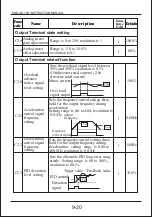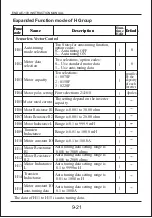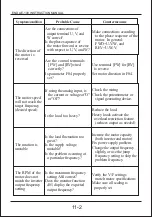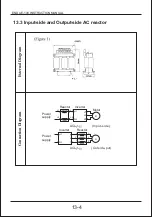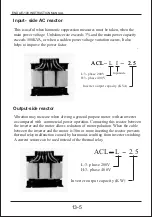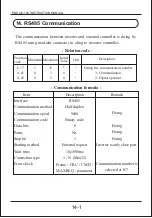
L1-L2
E1
U-V, V-W, W-U
(E ) (E ) (E )
U
V
W
R S T Current
(I
1
) (I
2
)
U, V, W current
(I ) (I ) (I )
U
V
W
L1-L2
W
1
U-V, V-W
(W )+(W )
01
02
Commercial
supply voltage
(200V class)
200~220V 50Hz
200-230V 60Hz
(400V class)
380-415V 50Hz
400-460v 60Hz
Pf =
¡
100(%)
0
¡
3
¤
E
¤
I
0
0
W
0
Pf =
¡
100(%)
1
E
¤
I
1
1
W
1
12.3 General Inverter Electrical Measurements
The following table specifies how to measure key system electrical param-
eters. The diagrams on the next page show inverter-motor systems the loca-
tion of measurement points for these parameters.
Parameter
Circuit location
of measurement
Measuring instrument
Notes
Reference
Value
Moving-coil type
voltmeter or recti-
fier type voltmeter
Rectifier type
voltmeter
Moving-coil type
Ammeter
Moving-coil type
Ammeter
Electronic type
wattmeter
Electronic type
wattmeter
Calculate the output power factor from the output
voltage E , output current I , and output power W
0
0
0
Supply voltage
E
1
Output voltage
E
0
Supply current
I
1
Output
I
current
0
Supply power
W
1
Output
W
power
0
Supply power
factor
Pf
1
Output
factor
Pf
0
power
Fundamental
wave effective
value
Total effe-
ctive value
Total effe-
ctive value
Total effe-
ctive value
Total effe-
ctive value
Total effe-
ctivevalue
Note 1:
Use a meter indicating a fundamental wave effective value for voltage,
and meters indicating total effective values for current and power.
Note 2:
The inverter output has a PWM waveform, and low frequencies may
cause erroneous readings. However, the measuring instruments and methods
listed above provide comparably accurate results.
Note 3:
A general-purpose digital volt meter (DVM) is not usually suitable to
measure a PWM waveform(not pure sinusoid)
12-4
ENDA E-100
INSTRUCTION MANUAL





